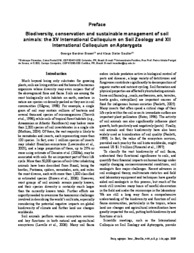Biodiversity, conservation and sustainable management of soil animals: the XV International Colloquium on Soil Zoology and XII International Colloquium on Apterygota.
Biodiversity, conservation and sustainable management of soil animals: the XV International Colloquium on Soil Zoology and XII International Colloquium on Apterygota.
Resumo: Much beyond being only substrates for growing plants, soils are living entities and the home of numerous organisms whose diversity may even surpass that of the aboveground flora and fauna. Soils are among the most biologically rich habitats on earth; nowhere in nature are species so densely packed as they are in soil communities (Hågvar, 1998). For example, a single gram of soil may contain millions of bacteria and several thousand species of microorganisms (Torsvik et al., 1996), while soils of tropical forest habitats (e.g., Amazonian or Atlantic Rainforests) may harbor more than 2,200 species of soil invertebrates in a single site (Mathieu, 2004). Of these, the vast majority is likely to be nematodes and insects, each representing more than 100 species. In fact, over 1 million species of insects may inhabit Brazilian ecosystems (Lewinsohn et al., 2005), and a large proportion of these, up to 25% or more using estimate of Decaëns et al. (2006a), may be associated with soils for an important part of their life cycle. More than 50,000 species of soil+litter inhabiting animals have been described from Brazil, being the beetles, Protozoa, spiders, nematodes, ants, and mites the most diverse, each with more than 1,000 classified or estimated species (Brown et al., 2006). However, most groups of soil animals remain poorly known, and their species diversity is certainly much larger than the currently known totals. Further efforts are urgently needed to overcome the taxonomic challenges involved in describing the world's soil biota, especially considering the potential negative impacts on global biodiversity of climate and further land use changes worldwide.
Ano de publicação: 2009
Tipo de publicação: Artigo de periódico
Unidade: Embrapa Florestas
Palavras-chave: Biodiversidade, Biodiversity, Colóquio internacional de zoologia do solo, Colóquio internacional sobre Apterygota, Comportamento sobre Apterygota, Ecologia, Espécies, Manejo sustentável de animais do solo, Monitoramento de biodiversidade, Pesquisa agropecuária brasileira, Species, Zoologia do solo
Observações
1 - Por padrão são exibidas publicações dos últimos 20 anos. Para encontrar publicações mais antigas, configure o filtro ano de publicação, colocando o ano a partir do qual você deseja encontrar publicações. O filtro está na coluna da esquerda na busca acima.
2 - Para ler algumas publicações da Embrapa (apenas as que estão em formato ePub), é necessário ter, no celular ou computador, um desses softwares gratuitos. Sistemas Android: Google Play Livros; IOS: iBooks; Windows e Linux: software Calibre.
Acesse outras publicações
Acesse a Base de Dados da Pesquisa Agropecuária (BDPA) para consultar o acervo completo das bibliotecas da Embrapa.

